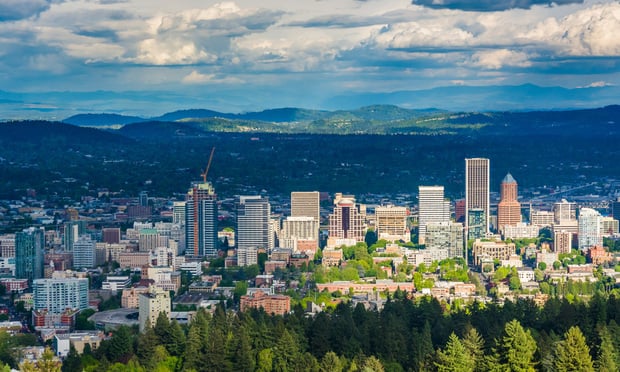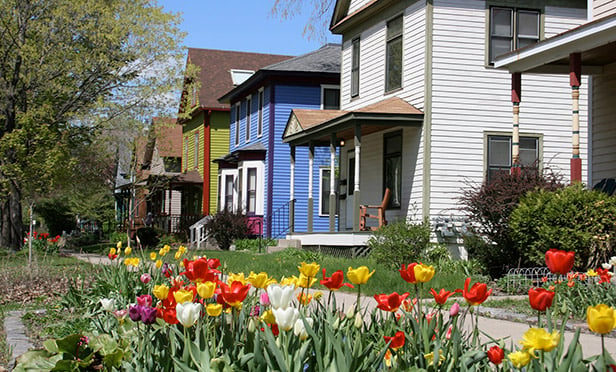PORTLAND, OR—As commercial real estate companies pivot to a new normal with the slow phased re-entry to the workplace, Unico Properties has a strategy to deliver a safe and sanitized office environment across its portfolio. This includes plans for US Bancorp Tower located at 111 SW 5th Ave.
The 1.2 million-square-foot tower is Portland's largest office building. As a LEED Platinum building, US Bancorp Tower already adheres to a much higher standard for air quality and overall health of the building environment.
Tenants at the building include US Bank, New Relic, SurveyMonkey, Miller Nash Graham & Dunn and Digital Trends. Prior to COVID-19, approximately 5,000 people moved through the class-A office building on a daily basis. While that number won't be the same with re-entry, Unico continues to prioritize meeting and exceeding its tenants' needs during the pandemic.
"Pre-pandemic, US Bancorp Tower saw about 4,000 to 5,000 people move through the building daily. It was a bustling environment, essentially like a small city," Keren Eichen, Unico Properties director of real estate services, tells GlobeSt.com. "The office environment will look different when tenants choose to return and it's our job right now to clearly communicate to them: here are the steps we 've taken to help you and here's how this affects you because this does affect everybody. Right now, we're seeing about 10% of our tenants in the building. It's a mix of tenants, most of which are focused on IT and server equipment so that people can work from home. We've informally surveyed our tenants and in conversations with them, we have learned that a large number of tenants are planning to come back full force once the restrictions are lifted. The number of tenants who want to return once restrictions are lifted surprised us. We expected it'd be about 5%, but it's much higher than that. When that happens, we're ready. We plan to personally call every tenant before they re-enter the building. We plan to ask each one 'what are your occupancy plans, your concerns about re-entry and your intentions?' We want to make personal contact with every tenant."
For re-entry at US Bancorp Tower, Unico has undertaken specific efforts at the building to provide the safest work environment possible for its employees, tenants, service partners and visitors.
"For our tenants, we want to make their journey from entering our parking structure to entering their office suite is as clean and safe as possible," Eichen tells GlobeSt.com. "Well before COVID, we were working on a long-term plan to future-proof the building, which included a $9 million elevator modernization. At that time, we had no idea about a global pandemic, we were just focused on creating the office of the future."
Tenant Survey: Unico surveyed its tenants to assess individual re-entry plans so that Unico can plan for occupancy in the building and learn more about what its tenants want most upon return to the building.
Premium Signage: Extremely large and clear signage in all communal spaces outlining social distancing guidelines, directional information, etc.
Building Entrances/Exits: Designated entrance and exit doors at all access points to minimize cross traffic as part of Unico's initiative to encourage distancing.
Elevators: Reprogrammed elevators will automatically limit the total number of people per car to four. Destination Dispatch software was designed to move people in the most efficient way possible. In pre-COVID times, this meant efficiently assigning elevators to take the most people to their destination with the fewest stops in between. Unico is now using a different feature that counts elevator occupants. It does this via interaction with the touchscreens that replaced traditional up/down elevator call buttons. National elevator consulting firm, Lerch Bates, evaluated the size of the interior elevator cab and determined that four occupants could socially distance in the elevators at US Bancorp Tower, so the maximum occupant count has been set at four. In addition, designated elevator queuing areas, as well as floor decals encouraging distancing in all elevators, including the parking structure elevators, are being implemented.
Stairwells: One internal stairwell in the building and one stairwell in the parking structure are open and available so tenants can avoid elevators if they so choose.
Separate HVAC units on each floor: This further isolates tenants to individual sources of air which comes directly from outside and recirculates back outside. In addition, Merv13 filters have been installed, which offer the best air quality because they capture microscopic particles such as airborne viruses and bacteria from coughs and sneezes. While there is no guarantee of protecting from coronavirus, this filter offers the assurance of breathing cleaner air.
Prioritized Janitorial Staff: The janitorial staff has been maintained throughout the pandemic to ensure buildings were highly sanitized. An enhanced cleaning protocol using Protexus electrostatic disinfectant was implemented in March which continues as tenants re-enter offices.
"We've always had a significant presence of day cleaning in the building and now our janitors are focusing on wiping down and sanitizing high-touch surfaces, which includes elevator buttons, door handles, our security desk counter, anything that someone would put their hands on," Eichen tells GlobeSt.com.
Furniture: Removal of all upholstered furniture and furniture in common areas where people congregated pre-COVID-19.
Masks: All Unico employees, building vendors and service providers are required to wear masks and they will encourage tenants and visitors to wear face coverings.
Supplies: Hand sanitizing stations within the lobby, with plans to install additional sanitizing stations throughout the common areas as they become available. The building has a two-month supply of cleaning products and paper supplies available on-site.
Contactless Parking: A contactless parking structure is available for tenants and visitors. The new mobile credentialing allows for touchless elevator usage from the lobby by using a cell phone. From the parking garage entry side, the camera will read a license plate, raise the gate and allow entry, thus allowing for contactless parking.
"You're not touching an access card, you're not pulling anything out, you're not wiping anything on the access reader and you're driving through," Eichen tells GlobeSt.com. "The HID App on tenants' phones functions exactly the same way a traditional access card does. With the HID App installed on your phone and registered in the building's access control system, a tenant can swipe their phone to access a locked floor in the same way that they'd swipe an access card to access a secure floor. As access control technology modernizes, we no longer use 'access cards' but rather 'credentials'. A credential can be a fob, access card or phones."
In some applications other than at US Bancorp Tower, there are credentials as secure as retinal scanning or fingerprint scanning. In other words, a credential is simply the method in which the security system recognizes a person as having rights to access a destination.
"US Bancorp Tower is our biggest individual building in our entire portfolio, but the portfolio is 75 buildings in six major markets across the country," Brian Pearce, Unico Properties executive vice president of real estate services, tells GlobeSt.com. "Four of those markets have actually reopened so they're much farther along in the process."
Occupational safety and health professionals use a framework called the "hierarchy of controls" to select ways of controlling workplace hazards. In other words, the best way to control a hazard is to systematically remove it from the workplace rather than relying on workers to reduce their exposure, according to the Occupational Safety and Health Administration.
During a COVID-19 outbreak when it may not be possible to eliminate the hazard, the most effective protection measures are (listed from most effective to least effective): engineering controls, administrative controls, safe work practices (a type of administrative control) and PPE. There are advantages and disadvantages to each type of control measure when considering the ease of implementation, effectiveness and cost. In most cases, a combination of control measures will be necessary to protect workers from exposure to COVID-19, says OSHA.
© Touchpoint Markets, All Rights Reserved. Request academic re-use from www.copyright.com. All other uses, submit a request to [email protected]. For more inforrmation visit Asset & Logo Licensing.







